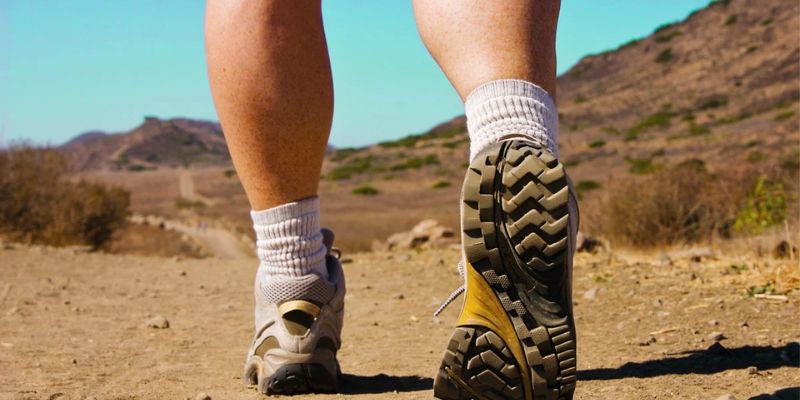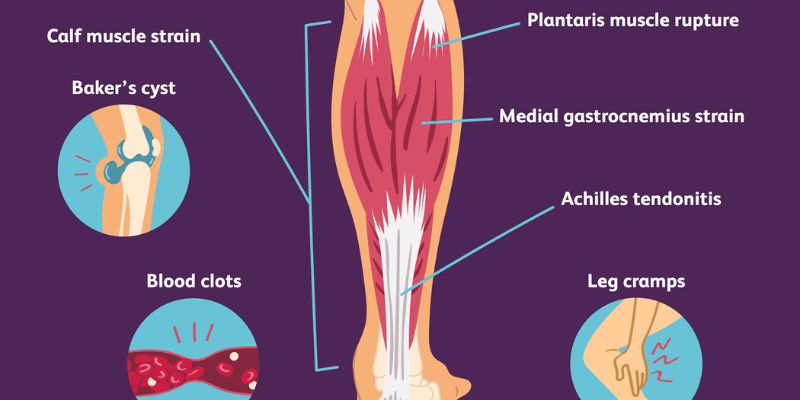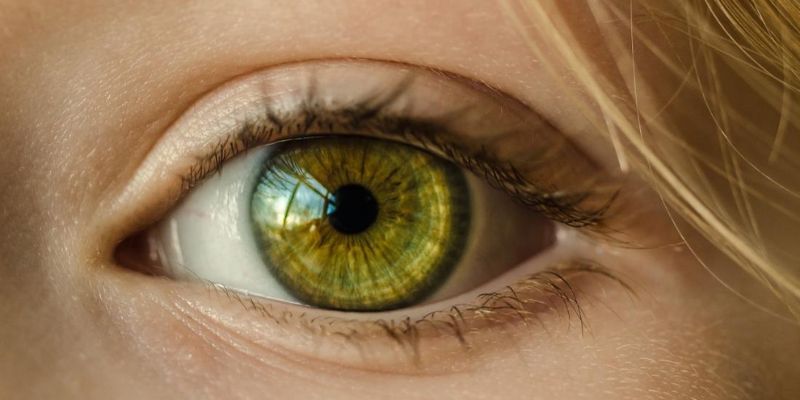Causes of Calf Pain and Treatment Options
Nov 21, 2023 By Madison Evans
Calf pain can be both debilitating and frightening. Pain in this area of your body can range
from a small, nagging ache to intense burning or stabbing sensations—and that's just the start! There are many possible causes of calf pain, including various injuries and conditions.
Let's dive into these potential sources of discomfort and treatment options available to help relieve any calf pain you may be experiencing.
What Calf Pain Feels Like

Calf pain can range from a mild, nagging ache to intense burning or stabbing sensations. Swelling, unusual coolness or pale color in the calf, tingling or numbness in the leg and calf, sudden weakness in one's leg, fluid retention, redness, and warm tenderness of the calf are all potential signs of a more serious condition.
It is important to seek medical attention if you experience any of these symptoms besides calf pain.
What Causes Calf Pain

Calf pain may stem from injuries to the calf muscles, tendons, bones, nerves, or blood vessels. Let's look at the main causes in detail:
Calf Muscle Cramp
Calf muscle cramps can range from a minor annoyance to an intense and painful experience. They often occur suddenly and may feel like a visible knot or twitching sensation in the calf area. Common causes include muscle fatigue, vitamin or mineral deficiencies, low iron levels, electrolyte imbalances, and certain medications.
Around 60% of adults experience nighttime calf cramps that may last up to nine minutes per episode. To reduce the risk of calf muscle cramps, it is important to ensure adequate hydration, replenish electrolytes after exercise, and take a multivitamin that contains B12 and D3.
Gastrocnemius Muscle Strain
Gastrocnemius Muscle Strain is an injury caused when the largest muscle in the calf is overstretched, resulting in small tears of the muscle fibers. It usually occurs during activities such as sprinting or jumping, which involve intense physical exertion.
People may experience a 'pop' sound during injury without feeling pain. However, sharp and tearing pain can occur after a few steps. Severe strains can cause swelling and bruising of the affected area, making walking difficult.
Soleus Muscle Strain
Soleus muscle strain is a common injury among runners, occurring when the soleus muscle is overused or stretched beyond its normal range of motion. Symptoms usually start with fatigue, including swelling, bruising, and sharp pain in the calf area.
Pain may be felt when pressing on the Achilles tendon, walking on your toes, or pulling your toes toward the shin.
Calf Muscle Contusion
Calf muscle contusions are common, painful injuries that occur when blood vessels beneath the skin's surface become torn or ruptured. They can be caused by falls, bumps, or direct trauma to the calf and may cause skin discoloration, tenderness, and severe pain.
Swelling may also limit mobility as well as hinder healing. In severe conditions, they can cause the formation of hematomas, which are pools of blood beneath the skin that require longer healing times or surgical drainage.
Plantaris Muscle Rupture
Plantaris muscle rupture is an injury that occurs when the ankle and knee are suddenly exposed to high pressure. It typically affects the small, superficial muscle behind the knee, which connects the gastrocnemius and soleus muscles.
When a plantaris muscle rupture occurs, people may feel an instantaneous snapping sensation in their leg accompanied by pain, swelling, bruising, and cramping. Pain may be immediate or take a few minutes to hours to manifest.
Achilles Tendinitis or Rupture
Achilles tendinitis and rupture are two common causes of calf pain. Tendinitis is characterized by a burning pain in the back of your leg just above your heel, calf pain, and stiffness.
A tendon rupture can cause severe, sudden pain in the back of your leg that makes it difficult to bear any weight on your leg. Sometimes, a "pop" may be heard when the injury occurs.
Baker's Cyst
A Baker's cyst, also known as a popliteal cyst, is a fluid that collects in the back of the knee due to arthritis. It can cause aching pain and swelling in the calf area if it ruptures and leaks into this region. Fortunately, the condition usually resolves on its own without any need for medical intervention.
Sciatica
Sciatica is a common condition caused by compression of the sciatic nerve, which runs from the lower back through each leg, ending in the calf. Symptoms such as burning or stabbing sensations, numbness, and tingling can be experienced.
Peripheral Arterial Disease
Peripheral Arterial Disease (PAD) is a serious condition caused by the buildup of fatty deposits in the arteries of the legs, resulting in cramping pain during activity.
People with PAD may experience pain in their buttocks, hips, thighs, calves, and feet while walking short distances and nighttime leg pain when lying in bed—signs that the condition is worsening.
Deep Vein Thrombosis
Deep vein thrombosis (DVT) is an extremely serious medical condition in which a blood clot forms in a deep vein of the leg. It can be brought on by extended periods of sitting, such as during a long plane ride or car trip.
People with pre-existing cardiovascular conditions, obesity, and other diseases are more likely to develop DVT. Symptoms include swelling, redness, warmth, and tenderness at the site of the obstruction.
Osteomyelitis
Osteomyelitis is a serious form of inflammation caused by bacterial infection. It can affect the bone tissue and impair its functionality, leading to constant, dull calf pain, redness, swelling, and fever.
Symptoms typically worsen over time if left untreated, so it is important to seek medical attention if you experience these symptoms in your leg or calf area.
Bone Fracture
Bone lower leg fractures, such as those in the tibia or fibula bones, can cause severe calf pain due to a fall or traumatic blow. These injuries typically lead to swelling and difficulty walking or bearing weight on the affected leg. A bone fracture can heal improperly if left untreated, leading to deformed legs or other medical issues.
When to See a Healthcare Provider
You should seek professional help when you feel any of the following symptoms:
- Inability to walk comfortably
- Deformity of the lower leg
- Calf pain that occurs at rest
- Calf pain that continues beyond a few days
- Inflammation of the calf or ankle joint area
- Signs of an infection, including fever, redness, and warmth
Diagnosis
Your doctor will ask about your medical history and symptoms, perform a physical examination, and order tests such as an X-ray, MRI, or CT scan to diagnose the cause of your calf pain.
Treatments
Treatment for calf pain depends on the underlying cause. Let's explore some of the most common treatments available.
RICE Method
The RICE method is the first line of treatment for calf pain and can help reduce swelling, inflammation, and discomfort.
It stands for rest, ice, compression, and elevation—all of which should be combined to get the best results. You can apply an ice pack or cold compress on your calf several times daily to reduce inflammation and relieve pain.
Stretching and Physical Therapy
Stretching and physical therapy are also recommended for treating calf pain. Stretches target the muscles around the affected area to relieve stiffness and improve the range of motion. Physical therapy may involve strength training exercises that build muscle strength in the calf area.
Medications
Medications can also be used to treat calf pain. Over-the-counter medications, such as ibuprofen and acetaminophen, are usually recommended for milder cases. Your doctor may prescribe stronger painkillers and anti-inflammatory drugs for more severe conditions.
If an infection is present, antibiotics may be required. In rare cases, surgery may be necessary to repair damaged tissue or remove any obstructions causing the pain.
FAQs
What is the best treatment for calf muscle pain?
The best treatment for calf muscle pain depends on the underlying cause. The RICE method (rest, ice, compression, and elevation) is often recommended to reduce inflammation and discomfort.
What are the symptoms of a bone fracture in the lower leg?
The most common symptoms of a bone fracture in the lower leg include intense pain, swelling, bruising, tenderness at the injury site, and difficulty walking or bearing weight on the affected leg.
What is the most common cause of calf pain?
The most common cause of calf pain is Achilles tendinitis or rupture.
Conclusion
A variety of injuries and medical conditions can cause calf pain. It is important to seek professional help if the symptoms worsen or fail to improve. Treatment options include the RICE method, stretching and physical therapy, medications, and in rare cases, surgery. Understanding the potential causes of calf pain and knowing when to see a healthcare provider will help you manage your condition effectively.
-
 Oct 03, 2023
Oct 03, 2023Why are My Eyes Yellow
Is your eye color changing to a yellowish hue? Learn why this happens and the possible causes, signs, and treatments that may accompany it. Get professional advice from the Why Are My Eyes Yellow blog today!
-
 Jan 22, 2024
Jan 22, 2024Benefits of Calendula
Learn more about the extraordinary healing properties that Calendula has been known for centuries, and discover why it's one of nature's most effective natural remedies!
-
 Dec 18, 2023
Dec 18, 2023Benefits of Olive Oil for Your Skin
Learn how to use olive oil to nourish and protect your skin from the outside. Discover the many benefits of this natural, nutrient-rich ingredient and how it can help promote healthier-looking skin!
-
 Feb 25, 2024
Feb 25, 2024Signs of Fibroids Breaking Down
Learn about the common signs and symptoms associated with fibroids breaking down, including pain, nausea, a bloated feeling, and more. If left untreated, they can have serious implications for overall health. Get informed today!
